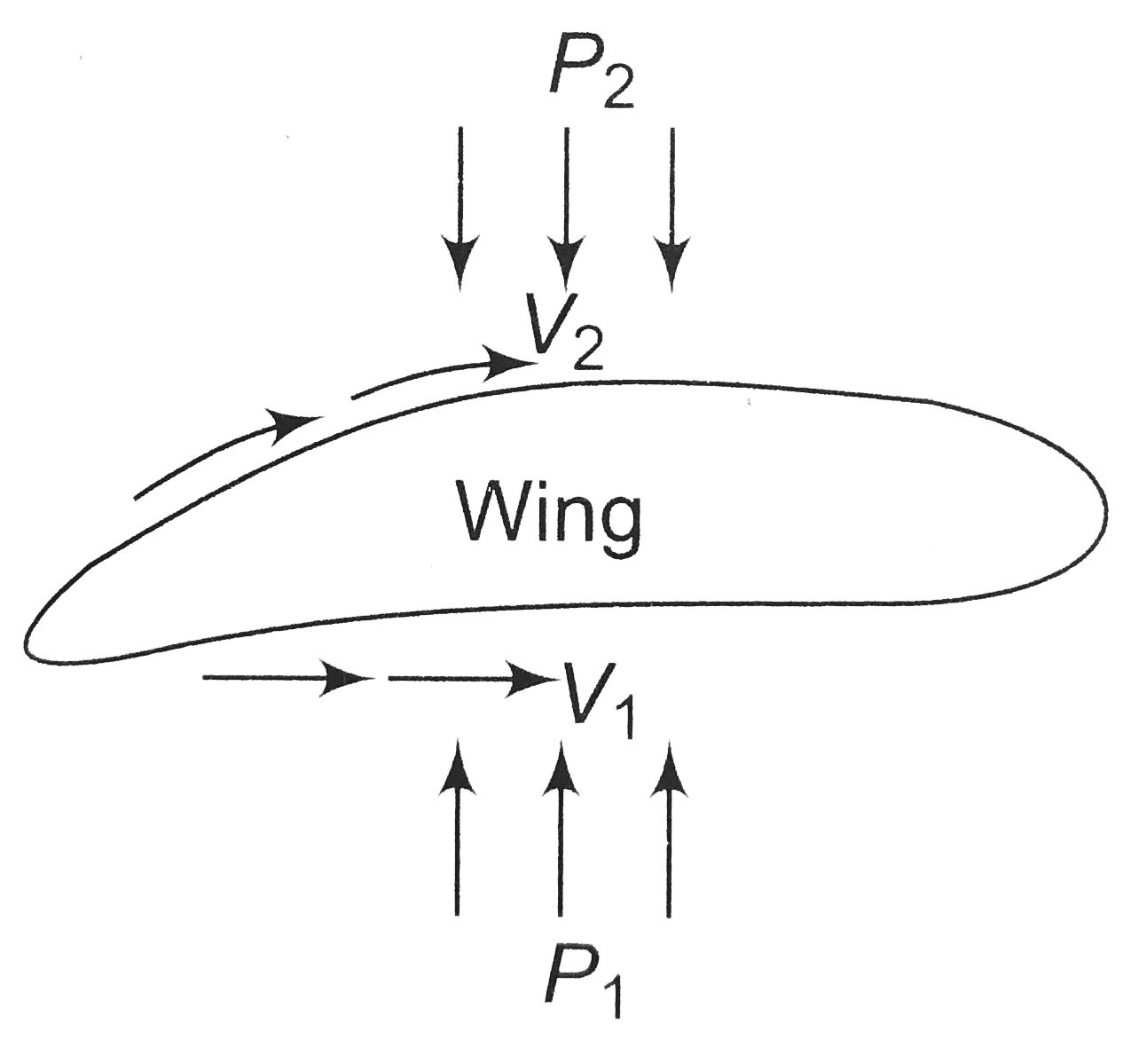The flow speeds of air on the lower and upper surfaces of the wing ofan aeroplane are v and √2v respectively. A is the area of the wing and ρ is the density of th e surrounding air. What is the force of the dynamic lift on the wing ?
12ρvA
12ρv2A
ρv2A
ρv22A
The correct Answer is:B
To find the force of dynamic lift on the wing of an airplane, we will use Bernoulli's principle, which relates the pressure difference between the upper and lower surfaces of the wing to the velocities of the air flowing over these surfaces.
1. Identify the given values:
- Speed of air on the lower surface, v1=v
- Speed of air on the upper surface, v2=√2v
- Area of the wing, A
- Density of air, ρ
2. Apply Bernoulli's equation:
Bernoulli's equation states that for incompressible flow, the sum of pressure energy, kinetic energy, and potential energy per unit volume is constant along a streamline. For our case, we can ignore the potential energy since the height difference is not given. Thus, we can write:
P1+12ρv21=P2+12ρv22
3. Rearranging Bernoulli's equation:
Rearranging the equation to find the pressure difference P1−P2:
P1−P2=12ρv22−12ρv21
4. Substituting the values of v1 and v2:
Substitute v1=v and v2=√2v:
P1−P2=12ρ(√2v)2−12ρv2
Simplifying this gives:
P1−P2=12ρ(2v2)−12ρv2=12ρ(2v2−v2)=12ρv2
5. Calculate the lift force:
The lift force FL is given by the pressure difference multiplied by the area of the wing:
FL=(P1−P2)⋅A
Substituting the pressure difference we found:
FL=(12ρv2)⋅A
6. Final expression for the lift force:
Thus, the force of dynamic lift on the wing is:
FL=12ρv2A
Final Answer:
The force of dynamic lift on the wing is FL=12ρv2A.
- Speed of air on the lower surface, v1=v
- Speed of air on the upper surface, v2=√2v
- Area of the wing, A
- Density of air, ρ
Bernoulli's equation states that for incompressible flow, the sum of pressure energy, kinetic energy, and potential energy per unit volume is constant along a streamline. For our case, we can ignore the potential energy since the height difference is not given. Thus, we can write:
P1+12ρv21=P2+12ρv22
Rearranging the equation to find the pressure difference P1−P2:
P1−P2=12ρv22−12ρv21
Substitute v1=v and v2=√2v:
P1−P2=12ρ(√2v)2−12ρv2
Simplifying this gives:
P1−P2=12ρ(2v2)−12ρv2=12ρ(2v2−v2)=12ρv2
The lift force FL is given by the pressure difference multiplied by the area of the wing:
FL=(P1−P2)⋅A
Substituting the pressure difference we found:
FL=(12ρv2)⋅A
Thus, the force of dynamic lift on the wing is:
FL=12ρv2A
The force of dynamic lift on the wing is FL=12ρv2A.
Topper's Solved these Questions
- BOOK - MARVEL PUBLICATIONCHAPTER - FRICTIONAL IN SOLIDS AND LIQUIDS EXERCISE - TEST YOUR GRASP10videos
FRICTIONAL IN SOLIDS AND LIQUIDS
- BOOK - MARVEL PUBLICATIONCHAPTER - FORCE, WORK AND TORQUEEXERCISE - TEST YOUR GRASP10videos
FORCE, WORK AND TORQUE
- BOOK - MARVEL PUBLICATIONCHAPTER - MAGNETIC EFFECT OF ELECTRIC CURRENT EXERCISE - TEST YOUR GRASP10videos
MAGNETIC EFFECT OF ELECTRIC CURRENT
Similar Questions
In a test experiement on a model aeroplane in a wind tunnel, the flow speeds on the lower and upper surfaces of the wing are υ and υ√2 respectively. If the density of air is ρ and the surface area of the wings is A, what is the dynamic lift on the wing of aeroplane.
View SolutionEach of the two wings of an aeroplane has area 30m2. The speed of the air on the upper and lower surfaces of theon the wing of aeroplane are 90ms−1 and 70ms−1 respectively. If the plane is in level flight at constant speed, find the uplift and the mass of the aeroplane. Given density of air =1.29kgm−3.
View Solution
Knowledge Check
- Question 1 - Select One
In a wind tunnel experiment the pressure on the upper and lower surfaces of the wings are 0.90×105Pa and 0.91×105Pa respectively. If the area of the wing is 40m2 the net lifting force on the wing is
A2×104NB4×104NC6×104ND8×104N - Question 2 - Select One
An aircraft is moving on a runway for its take off. The wind speed on the lower and upper surface of the wings are 'v' and '√2'v. If the density of air is ρ and surface area of the wing is A, the upward force exerted on thei wings will be
A√2ρv2AB1√2ρv2AC2ρv2AD12ρv2A - Question 3 - Select One
In a test experiment on a model aeroplane in a wind tunnel, the flow speeds on the upper and lower surfaces of the wing are 70ms−1 and 83ms−1 respectively. What is the lift on the wing, if its area is 2.5m2? Take the density of air to be 1.3kgm−3
A1513NB1513 dinesC151.3 ND151.3 dynes
In a test experiment on a model aeroplane in a wind tunnel, the flow speeds on the upper and lower surface of the wing are 70ms−1and63ms−1 respectivley. What is the lift on the wing if its area is 2.5m2? Take the density of air is 1.3kgm−3.
View SolutionAn aeronautical engineer observed that on the upper and the lower surface of the wing of an aeroplane the speed of the air are 120ms−1and90ms−1 respectively during flight. What is the lift on the wing of aeroplane if its area is 3.2m2? Given density of air is 1.29kg/m3.
View SolutionIn a wind tunnel experiment the pressure on the upper and lower surfaces of the wings are 0.90×105 Pa and 0.91 ×105Pa respectively .If the area of the wings is 40m2 the net lifting force on the wing is
View SolutionThe velocity of the wind over the surface of the wing of an aeroplane is 80ms−1 and under the wing 60ms−1. If the area of the wing is 4m2, the dynamic lift experienced by the wing is [density of air =1.3kg.m−3]
View SolutionThe speed of flow past the lower surface of a wing of an aeroplane is 50ms−1. What speed of flow over the upper surface will give a dynamic lift of 1000Pa? Density of air =1.3kgm−3
 View Solution
View Solution

